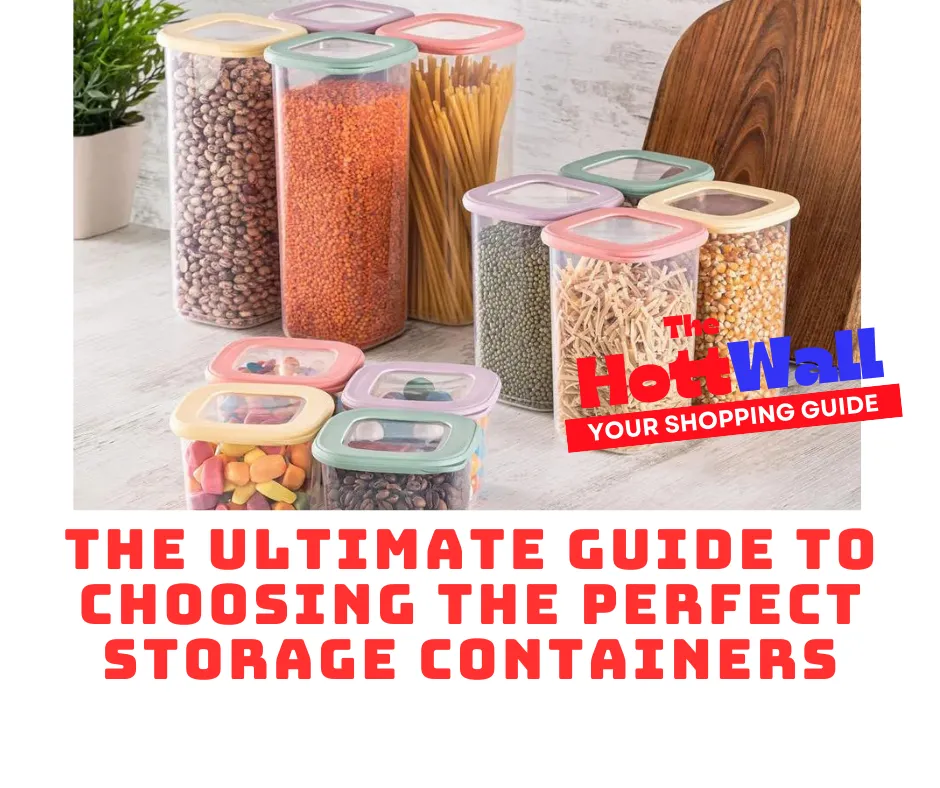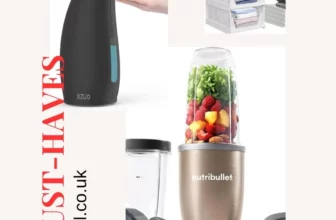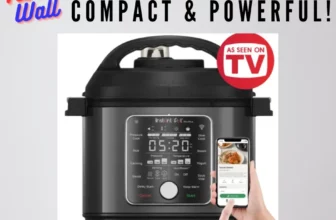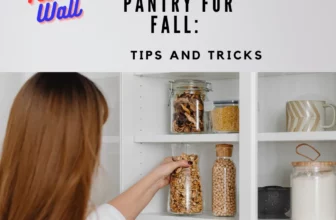
Introduction
In today’s fast-paced world, keeping your kitchen organized is more than just a matter of convenience—it’s about saving time, money, and reducing food waste. One of the key elements to achieving a well-organized kitchen is choosing the right food storage containers. Whether you’re meal-prepping, storing leftovers, or keeping your pantry in check, selecting the best containers can make a big difference. This ultimate buying guide will walk you through the essentials of choosing the best food storage containers to keep your home organized, while also ensuring your food stays fresh.

Table of contents
Why Food Storage Containers Matter
Effective food storage is more than just putting food away. It’s about preserving its quality, ensuring it stays fresh for as long as possible, and minimizing waste. Here are some key reasons why having good-quality food storage containers is essential:
- Preservation of Freshness: Good containers prevent air, moisture, and bacteria from getting in, ensuring that your food stays fresher for longer.
- Waste Reduction: Storing leftovers or excess food properly reduces waste, allowing you to reuse meals or ingredients efficiently.
- Organization and Space Saving: High-quality storage containers stack neatly and allow you to maximize your kitchen space, whether in the fridge, freezer, or pantry.
- Portability: With secure lids and leak-proof designs, modern containers are great for taking meals to work, school, or while traveling.
Types of Storage Containers
There are many types of food storage containers available on the market. The key is to choose containers that suit your specific needs and preferences. Below are the most common types:
Food Storage Containers
Food storage containers are designed to keep your leftovers, meal preps, and pantry items fresh. They come in various sizes, from small snack containers to large ones for bulk storage. These containers often feature airtight lids to preserve the freshness of your food.
Stackable Containers
Stackable containers are perfect for maximizing space in your kitchen. They are designed to nest on top of each other, making them ideal for organizing your pantry or refrigerator. These containers often come in uniform shapes and sizes for easy stacking.
Freezer Food Storage Containers
Freezer storage containers are specifically designed to withstand freezing temperatures without cracking or breaking. They often have airtight seals to prevent freezer burn and keep your food fresh for longer periods.
Vacuum-Sealed Containers
Vacuum-sealed containers use a vacuum pump to remove air from the container, extending the shelf life of your food. These containers are ideal for preserving perishable items and preventing the growth of bacteria.
Microwave-Safe Containers
Microwave-safe containers are made from materials that can withstand high temperatures without releasing harmful chemicals. They are perfect for reheating leftovers or preparing meals in the microwave.
Glass Storage Containers
Glass containers are durable, non-porous, and can go from the refrigerator to the oven. They do not retain odors or stains, making them ideal for a variety of foods. Glass containers are also microwave-safe and dishwasher-safe.
Materials of Storage Containers
The material of a storage container can significantly impact its functionality and durability. Here are some common materials used for containers:
1. Plastic Food Storage Containers
Plastic containers are lightweight, affordable, and come in various sizes and shapes. They’re highly versatile, perfect for everything from meal prep to pantry organization.
Advantages:
- Affordable and widely available
- Lightweight and portable
- Often come with stackable designs
- Microwave- and dishwasher-safe (depending on the brand)
Disadvantages:
- Can retain odors or stains
- Not as durable as glass
- May contain BPA or other harmful chemicals (look for BPA-free options)
Best for: Short-term storage, lightweight meal prep, pantry organization, taking food on the go.
2. Glass Food Storage Containers
Glass containers are gaining popularity due to their durability, non-toxic material, and aesthetic appeal. They’re heavier than plastic but can handle heat better, making them ideal for reheating food.
Advantages:
- Durable and long-lasting
- Safe for microwave, oven, freezer, and dishwasher
- Does not retain odors or stains
- Non-toxic and BPA-free
Disadvantages:
- Heavier and more fragile than plastic
- More expensive
Best for: Long-term food storage, baking, and reheating meals, pantry organization.
Stainless Steel
Stainless steel containers are durable, resistant to staining, and do not retain odors. They are often used for storing dry goods and can be found in a variety of sizes.
Advantages:
- Durable and resistant to damage
- Does not retain odors or stains
- Eco-friendly and recyclable
Disadvantages:
- Not microwave safe
- Can be more expensive than plastic or glass
Key Features to Look for in Food Storage Containers
When selecting the best food storage containers, there are several important features to consider. These will ensure your containers are practical, safe, and durable.
1. Airtight Seals
The most important feature of any food storage container is an airtight seal. This prevents air from getting in and spoiling your food. Look for containers with rubber or silicone gaskets in the lid to ensure a tight seal, which helps prolong the freshness of your food.
2. Leak-Proof Design
For those who frequently take food on the go or store liquids, a leak-proof container is a must. Containers with snap-lock lids or twist-tight designs are ideal for ensuring that soups, stews, and sauces won’t spill.
3. BPA-Free Materials
BPA (Bisphenol A) is a chemical often found in plastics and can be harmful if ingested over time. Always look for containers labeled as BPA-free, especially when selecting plastic options.
4. Microwave and Freezer Safe
If you plan to reheat or freeze food, make sure your containers are microwave and freezer safe. Glass and BPA-free plastic containers are typically safe for both, but always check manufacturer guidelines.
5. Stackability
For an organized kitchen, it’s crucial that containers stack well. Stackable designs not only save space in your cabinets, fridge, or freezer but also make it easy to see what’s stored.
6. Durability
Consider how long-lasting the container materials are. Glass and stainless steel tend to be more durable than plastic, while plastic containers may need replacing over time.
Specialized Food Storage Containers
In addition to general storage containers, there are specialized options designed to store specific types of food more effectively. Some of these include:
1. Produce Keepers
These containers are specifically designed to extend the life of fruits and vegetables by controlling moisture levels and airflow. Some models have adjustable vents to create the perfect environment for each type of produce.
2. Dry Food Canisters
These are ideal for pantry storage of dry goods like pasta, grains, flour, and cereal. Often made from glass or plastic, they usually have wide openings for easy access and airtight seals to keep contents fresh.
3. Portion Control Containers
Perfect for meal prep or those on a diet, portion control containers help you measure out servings accurately. They’re often color-coded or labeled for specific food groups to make portioning easy.
4. Vacuum-Sealed Containers
These containers use vacuum technology to remove air from the container, further extending the shelf life of your food. They’re especially useful for storing meat, cheese, and other perishable items.
Maintenance and Care Tips for Food Storage Containers
To ensure your food storage containers last as long as possible, follow these maintenance and care tips:
- Avoid Staining: To prevent staining, avoid storing foods like tomato sauce in plastic containers for prolonged periods. Glass containers are better suited for acidic or strongly colored foods.
- Clean Properly: Always follow the manufacturer’s cleaning instructions. Most containers are dishwasher-safe, but some lids may need to be hand-washed to preserve the airtight seal.
- Check for Wear and Tear: Regularly inspect your containers for cracks, broken seals, or warping, especially plastic ones, and replace them if necessary.
Final Thoughts
Food storage containers are essential tools for maintaining a well-organized kitchen, reducing waste, and keeping your food fresh for longer. Whether you prefer plastic, glass, or stainless steel, the best containers for your home will depend on your needs, habits, and preferences. With this guide, you’ll be able to choose the best food storage solutions that fit seamlessly into your lifestyle.
Happy organizing!
FAQ’s for Perfect Storage Containers
Can I use plastic containers in the microwave?
Not all plastic containers are microwave safe. Look for containers labeled as microwave-safe and always check the manufacturer’s guidelines.
How do I remove stains from my plastic containers?
To remove stains, soak the container in a mixture of warm water and baking soda or use a gentle scrub with vinegar. Rinse thoroughly afterward
Are glass containers safe for freezing?
Yes, most glass containers made from borosilicate glass are safe for freezing. However, avoid sudden temperature changes to prevent cracking.
Can stainless steel containers be used for acidic foods?
Yes, high-quality stainless steel containers are resistant to corrosion and can safely store acidic foods.
How do I prevent my containers from retaining odors?
To prevent odors, clean containers thoroughly after each use and allow them to air dry completely before storing. Using a mixture of baking soda and water can help neutralize odors.








